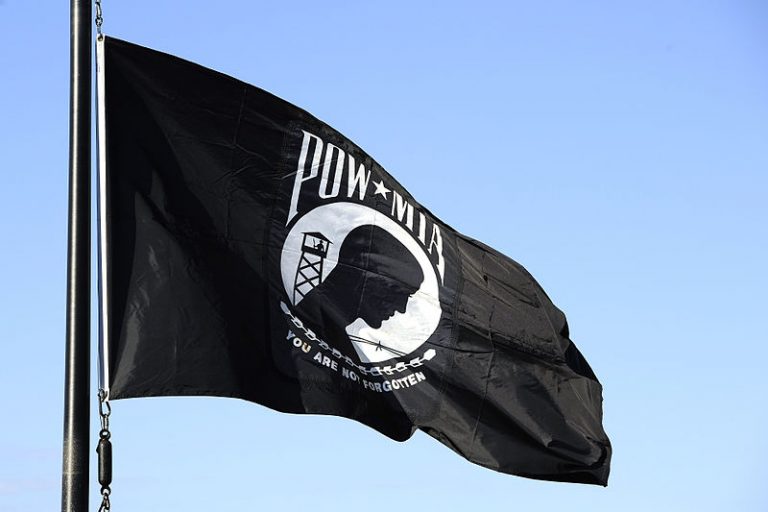
Tech. Sgt. Harold Lynn Seifreid is unknown no more.
The 31-year-old Army Air Forces radio operator was buried with full military honors at Arizona Veterans’ Memorial Cemetery in Marana on Friday, 80 years after his bomber was shot down over Southeast Asia during World War II.
In February, the Defense POW/MIA Accounting Agency announced it had identified Seifreid’s remains, which were recovered from the crash site in Burma, now known as Myanmar, in 1947.
For 73 years, Seifreid was buried with his crewmates in a grave marked “Unknowns” at the National Memorial Cemetery of the Pacific in Honolulu, Hawaii.
His remains were exhumed in 2020 and positively identified in November by scientists from the accounting agency and the Armed Forces Medical Examiner System, who used DNA, dental and anthropological analysis, as well as material and circumstantial evidence.
Seifreid was serving with the 436th Bombardment Squadron, 7th Bombardment Group in India on Dec. 1, 1943, when his B-24 Liberator was shot down during a bombing mission over a rail yard north of the city of Rangoon, now known as Yangon.
Witnesses in other aircraft reported seeing the bomber get hit by anti-aircraft fire and disappear into the clouds with its left wing on fire and three enemy fighters in pursuit.
With no other clues about what happened to the B-24, its crew was listed as “Missing in Action.”
In 1947, the U.S. Army Graves Registration Service recovered what they believed to be the remains of eight individuals from a possible B-24 crash near Yodayadet, Burma. Local villagers had buried bodies from the wreckage in two large graves at the direction of Japanese forces in the area, according to a news release from the accounting agency.
The remains could not be scientifically identified at the time of their recovery.
Seifreid was originally from Philadelphia, but he was buried in Marana because his nephew, Mike Lowry, lives nearby in Oro Valley.
Lowry said the family originally considered a veterans cemetery in Seifreid’s native Pennsylvania, but none of the man’s relatives live in the area anymore.
“Then who would visit?” he said. “I wanted someone to be able to visit him, to honor him occasionally on Veterans Day and times like that.”
Lowry, now 75, was born six years after Seifreid died. He knew he had an Uncle Harold who was lost in the war, but he didn’t know anything else about the man beyond that.
Then in late 2022, Lowry said, he was contacted out of the blue by a group that wanted a sample of his DNA in hopes of identifying the missing serviceman.
“I thought it was some form of a scam at first,” he said.
Since then, Lowry has learned a lot more about his uncle’s final mission from “different accounts and the records they gave us,” he said.
It is his understanding that Seifreid’s stricken B-24 managed to stay in the air and fly for another 60 miles before crashing, which may have complicated later efforts to find the wreckage and recover the missing crew.
It was Lowry and his cousin in Michigan, Denise Huebner, who ended up providing the genetic samples that finally led to the identification. Late last year, they were informed that Seifreid’s identity had been confirmed.
The American flag that flies over the cemetery in Marana was lowered to half staff and an honor guard was brought in from Fort Huachuca for Friday’s ceremony.
A rifle company fired a salute and a bugler sounded taps as about 40 people gathered in front of the flag-draped coffin.
After the flag was meticulously folded and presented to him, Lowry thanked everyone who had worked so hard for so long to honor his uncle and return him to his family.
Choked with emotion, the Air Force veteran with two tours of duty in Thailand during the Vietnam War credited “science and American doggedness” for finally completing the mission after 80 years.
The headstone on Seifreid’s grave in Marana includes his name, rank and where he served, along with the words, “Home at last, never forgotten.”
The tech sergeant’s name was already etched in limestone on the Walls of the Missing at the Manila American Cemetery and Memorial in the Philippines, along with those of more than 36,000 other service members still unaccounted for from the Pacific Theater during World War II.
A rosette will be placed next to Seifreid’s name on the memorial to indicate he has been accounted for.
___
(c) 2024 The Arizona Daily Star
Distributed by Tribune Content Agency, LLC.
0 comments :
Post a Comment